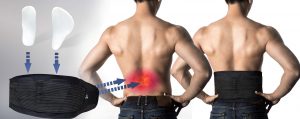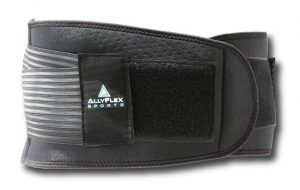Back Brace for Lower Back Pain Relief
Neo Sports Lab is specialized in making support braces and sleeves for human and pets. The back brace for lower back pain relief is one of the best selling products on market. Owing to its ergonomic design and the 3D Lumbar Pads, which are perfectly placed to support lower back muscles from all ankles, plus the high quality perforated neoprene and the COOLMAX Fiber Lining to transform moisture and wick it away quickly, this lower back support brace is extremely effective and comfortable to wear.
Lower Back Pain – A Common Problem
If you have lower back pain, you are not alone. According to NIH (National Institute of Neurological Disorders and Stroke), about 80 percent of adults experience low back pain at some point in their lifetimes. It is the most common cause of job-related disability and a leading contributor to missed work days. In a large survey, more than a quarter of adults reported experiencing low back pain during the past 3 months.
Benefit of Using a Back Brace for Lower Back Pain Relief
Lower back pain occurs in a revolving circle of inflammation and muscle spasm caused by an acute injury or a chronic condition that flare up. When this happens, the spinal musculature contracts into involuntary spasm or voluntary contraction of the muscles to protect the injured or inflamed joint or soft tissue structure(s). The muscles then go into “overdrive” mode with good intentions of protecting the spine. Thus the vicious circle of pain and spasm begins. There are numerous ways to break into that vicious circle: medication, physiotherapy (including ice, heat, modalities, stretching, strengthening, manual therapy etc.) And lastly, as an external stabilizer: a lower back support brace.
When using a back brace for lower back pain relief, it allows the core muscles that are supporting the spine to relax and not be in “overdrive protection mode “all the time, and thus reduce or relieve the lower back pain.
A typical lower back brace is made from materials with some level of elasticity, such as neoprene, and most have one or two compression straps that pull the back brace snugly around you. When the straps are pulled, a compression is created to the core musculature resulting in an overall decrease in volume of the intra-abdominal soft tissue. It is this decrease in volume of soft tissue that acts as a STABILIZER directly surrounding the spine.
Some of the lower back support braces come with lumbar support, in medal or hard plastic form, flat or 3-D shape (our lower back support brace comes with two 3-D hard plastic lumbar pads). These lumbar support pads, when compressed by the compression straps, enhance the magnitude of decrease in volume of soft tissue surrounding the spine. If design and place correctly, a 3-D shaped lumbar pads produce more compression from different angles at different levels, and thus dramatically increase such enhancement in lower back pain relief. So when choose a back brace for lower back pain, it is always a better choice to use a back brace with lumbar support.
The other important advantage that a lower back support brace provides is PROPRIOCEPTION. By definition from Dictionary.com, proprioception is: The unconscious perception of movement and spatial orientation arising from stimuli within the body itself. In humans, these stimuli are detected by nerves within the body itself, as well as by the semicircular canals of the inner ear. The lumbar support back brace provides external proprioception to the person wearing the brace allowing them to move, sit, and maintain a better posture while recovering from their injury. So this gives another reason to use a back brace with lumbar support – improve posture.
Mechanisms of back brace for lower back pain relief
- Provide additional spinal support. A back brace, especially the back brace with lumbar support can add stability when the low back is unstable due to injured or weakened spinal structures. By holding the torso in a safe, supportive posture, a back brace can help provide a healthy healing environment for the current injury and prevent additional injuries.
- Reduce pressure on the spinal structures. A lower back support brace can help unload some of the weight normally placed on the lower back, in the process reducing pressure on the spine’s joints, discs, and muscles. By reducing spinal pressure, a back brace can lessen painful muscle tension that is a common protective reaction following an injury.
- Reduce range of motion during healing. A lumbar support back brace is used to prevent or restrict painful movements, such as twisting the spine or bending forward, backward, or to the side. Limiting painful movements and postures can also help improve awareness of the body’s positioning (proprioception), which allows the wearer to consciously adjust posture for improved back health.
- Reduce micro-motion between vertebral segments. lower back support braces also limit excess micro-movements at a particular spinal segment or vertebral fracture, thereby limiting pain from muscle tension and irritated joints or nerve roots.
How to choose a back brace for lower back pain relief
- Compression – After all, compression is the basis of a lower back support brace. A back brace with adjustable compression straps can provide the compression level to personal preference.
- Lumbar Support – A lower back brace with lumbar support can enhance the healing of lower back pain. It also helps spine and posture support. Some lumbar support back braces provide removable lumbar pads, which can be taken out so the back brace can used as back support belt for activities that require more flexibility such as lifting.
- Custom Fit – This is probably the most important feature when it comes to choose a back brace for lower back pain support. A well designed back brace makes a huge difference. Size is also an important factor. Braces that have more sizes are always better choice than those with “one-size fits all” or fewer choices in sizes.
- Comfort – Since a back brace would be used for hours or even all day, it is essential to choose one that is comfortable to wear. Sometimes, it is better to wear the brace next to the skin to be more effective, so a lower back support brace with a comfortable inner layer is always a better choice.
How to Use and Wear a back brace for lower back pain relief
It is important to wear a back brace according to the instructions provided with the brace and/or advised by the prescribing doctor. Many braces are fitted specially for the patient’s needs and body, and if worn incorrectly can cause further injury and worsened pain.
A typical lower back support brace has a soft layer and can be worn directly against bare skin. But wearing a shirt under the brace is usually needed to minimize skin irritation.
General steps in putting on a lower back support brace:
- Wrap the brace around the back with the wings against either side of the torso
Connect the two ends across the abdomen - Make sure the lumbar support pads (if any) are correctly placed (snugged) against spine
- Make more precise adjustments to the tightness and pressure in the brace
- Pull strap tabs on either side of the brace to add more compression
- Most back braces are not designed to be machine washed or dried—it is generally advised to hand wash the brace using water and a mild soap. Any additional padding or panels should be removed first and washed separately. A brace should be laid flat or hung to dry. Make sure the brace is rinsed thoroughly and dried completely before wearing.




